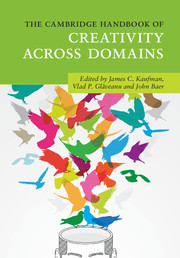Book contents
- The Cambridge Handbook of Creativity Across Domains
- The Cambridge Handbook of Creativity Across Domains
- Copyright page
- Dedication
- Contents
- Figures
- Tables
- Contributors
- Acknowledgments
- Part I Creativity and Domain
- Part II Creativity in the Traditional Arts
- 5 The Creativity of Literary Writing
- 6 Creativity in the Visual Arts
- 7 The Creation and Aesthetic Appreciation of Architecture
- 8 Photography and Creativity
- 9 The Constricted Muse
- 10 Musical Creativity
- 11 Dance
- Part III Creativity in the Sciences
- Part IV Creativity in Business
- Part V Newer Domains for Creativity Research
- Part VI Creativity in Everyday Life
- Part VII Conclusion
- Index
- References
9 - The Constricted Muse
Acting
from Part II - Creativity in the Traditional Arts
Published online by Cambridge University Press: 15 September 2017
- The Cambridge Handbook of Creativity Across Domains
- The Cambridge Handbook of Creativity Across Domains
- Copyright page
- Dedication
- Contents
- Figures
- Tables
- Contributors
- Acknowledgments
- Part I Creativity and Domain
- Part II Creativity in the Traditional Arts
- 5 The Creativity of Literary Writing
- 6 Creativity in the Visual Arts
- 7 The Creation and Aesthetic Appreciation of Architecture
- 8 Photography and Creativity
- 9 The Constricted Muse
- 10 Musical Creativity
- 11 Dance
- Part III Creativity in the Sciences
- Part IV Creativity in Business
- Part V Newer Domains for Creativity Research
- Part VI Creativity in Everyday Life
- Part VII Conclusion
- Index
- References
Summary
While most laypeople and audience members would easily and quickly put acting in the “creative arts” category, what is actually creative about portraying the words of a playwright, in a recognizable manner, for many performances? Acting does not necessarily involve generation of new material – rather, most acting takes place in a collaborative environment, as an interpretation of a playwright’s, director’s, and designer’s combined and unified vision. We therefore break down the issue of creativity in acting into three components: the process of creating a performance, the person creating the performance, and the product of the performance itself. We review the scant literature in this area, and conclude with research suggestions both for how to determine if an actor’s performance is creative, and for how to define and measure the process of acting through the lens of creativity.
- Type
- Chapter
- Information
- The Cambridge Handbook of Creativity across Domains , pp. 145 - 160Publisher: Cambridge University PressPrint publication year: 2017
References
- 2
- Cited by

